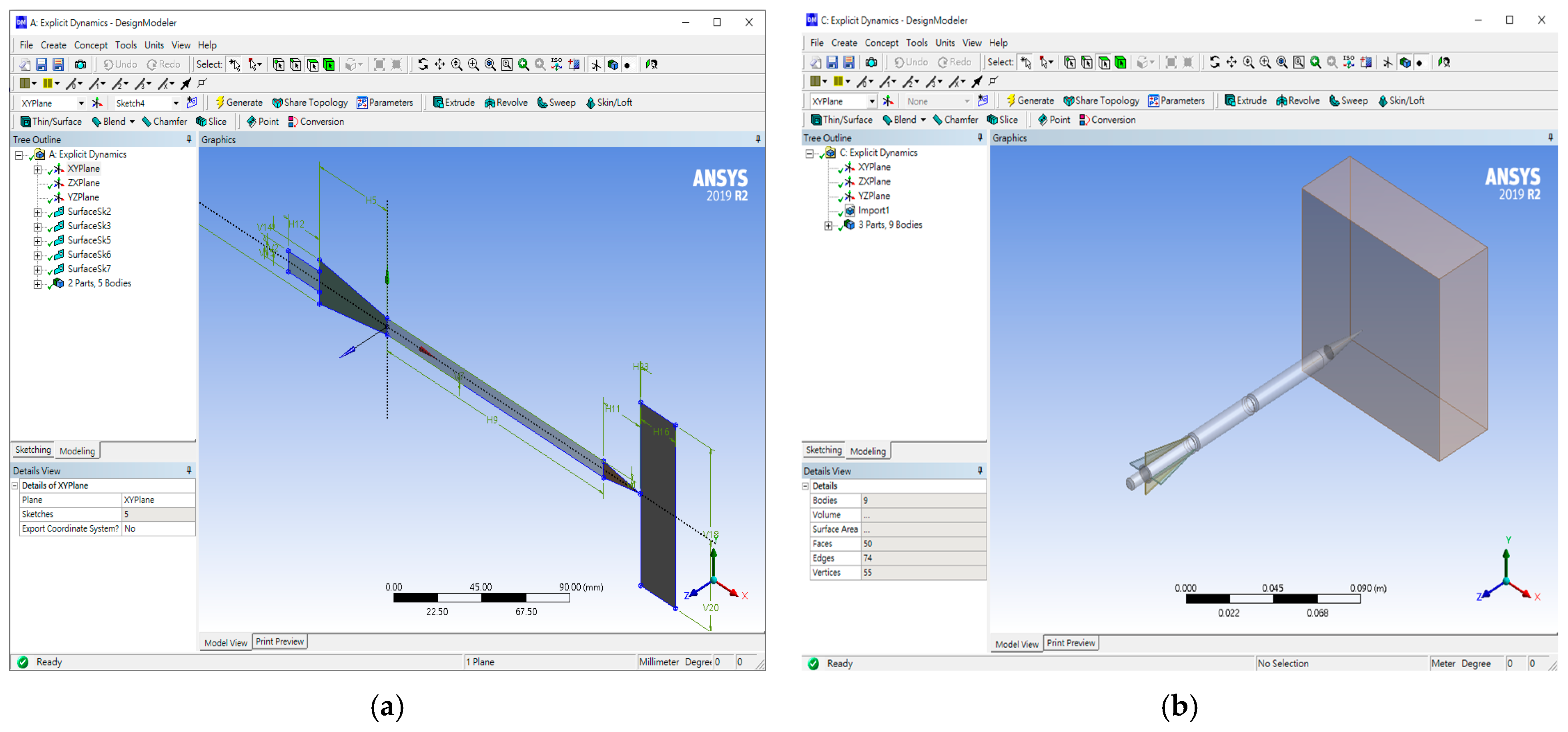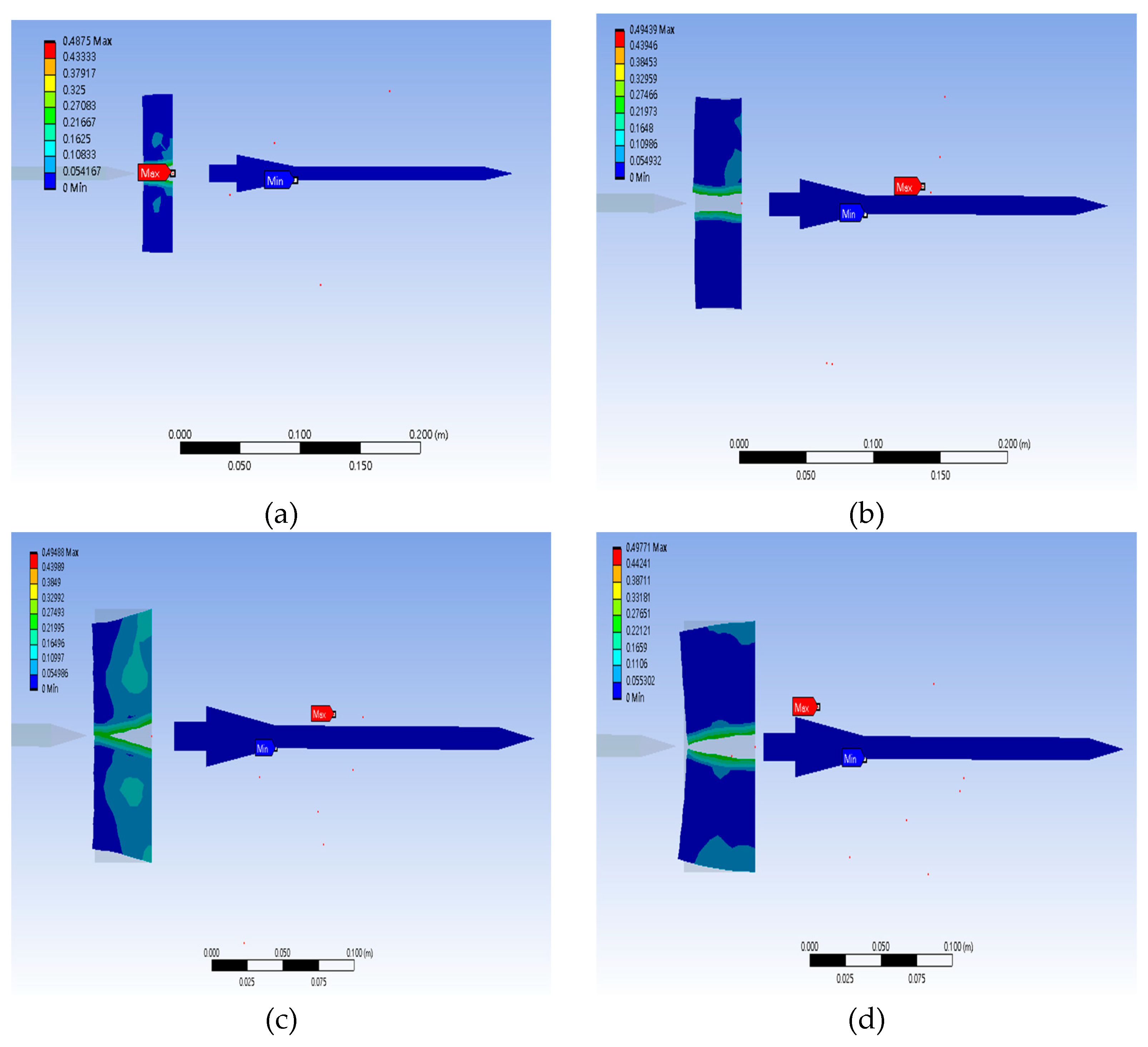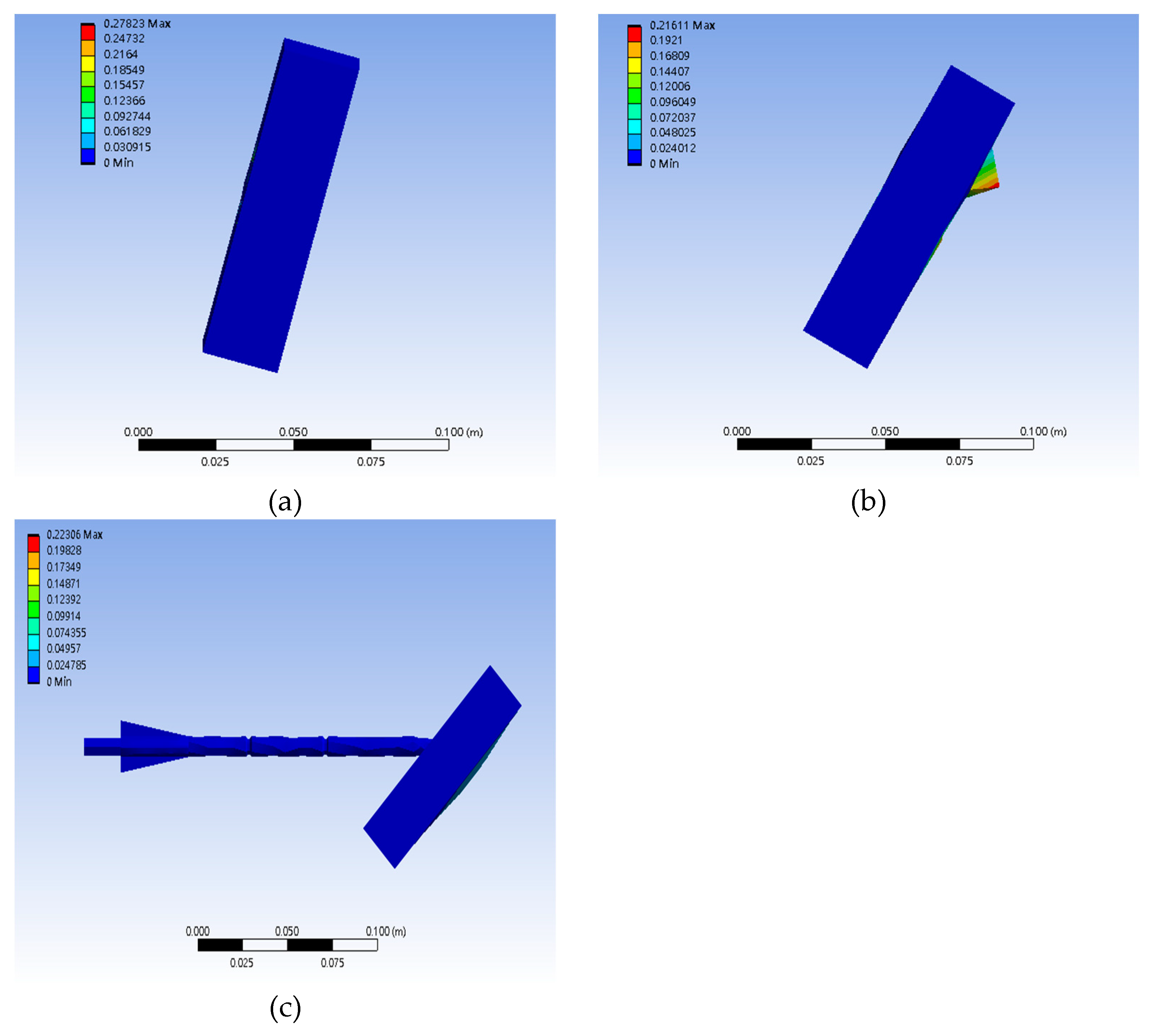Numerical Simulation Analysis of Penetration Performance of Armor-Piercing Fin-Stabilized Discarding Sabot to Steel Plate †
Abstract
:1. Introduction
2. Numerical Analysis
2.1. 30 mm Armor-Piercing Fin-Stabilized Discarding Sabot Geometry
2.2. Reference Armor Firing Rate
2.3. Two-Dimensional and Three-Dimensional Models for Simulation Analysis
3. Results and Discussion
4. Conclusions
- Through numerical simulation analysis, we calculated the penetration depth of the steel plate at different impact speeds. The greater the impact speed, the greater the depth of the steel plate that can be penetrated.
- The analysis of changing the density of the tungsten rod shows that the density of the tungsten rod increases, and the increased thickness of the armor-piercing tracer that can penetrate the steel plate increases.
- By changing the design and installation angle of the steel plate under the stable firing muzzle velocity, the armor-piercing tracer cannot penetrate the steel plate and only causes a certain degree of damage around the surface of the steel plate when it is placed at an inclination of 45°. The steel plate can be penetrated only by firing at the same range of shooting points. The analysis and research data can be used for evaluation and reference by the developers of the subsequent design of armored vehicles.
Author Contributions
Funding
Institutional Review Board Statement
Informed Consent Statement
Data Availability Statement
Conflicts of Interest
References
- MIL-STD-367 Armor Test Data Reporting. 1986. Available online: http://everyspec.com/MIL-STD/MIL-STD-0300-0499/MIL-STD-367_29115/ (accessed on 17 May 2019).
- MIL-STD-662F Department of Defense Test Method Standard v50 Ballistic Test for Armor. 1997. Available online: http://everyspec.com/MIL-STD/MIL-STD-0500-0699/MIL-STD-662F_6718/ (accessed on 21 May 2019).
- MIL-A-12560H (MR) w/INT. Amendment 4 Armor Plate, Steel, Wrought, Homogeneous (for Use in Combat-Vehicles and for Ammunition Testing). 2007. Available online: http://everyspec.com/MIL-SPECS/MIL-SPECS-MIL-A/MIL-A-12560H_AMENDMENT-3_10355/ (accessed on 21 May 2019).
- Kuo, H.-T. Simulations for the Dynamics of Sabot Discard and the Projectile Trajectory. Master’s Thesis, Chung Yuan Christian University, Taoyuan, Taiwan, 2004. [Google Scholar]
- Fu, S.-M. Study of Aerodynamic Characteristics of a Tail Fin-Stablized Projectile; Chung Cheng Institute of Technology, National Defense University Department of Mechanical and Aerospace Engineering: Taoyuan, Taiwan, 2013. [Google Scholar]



| Range (Meter) | Remain Velocity (m/s) |
|---|---|
| 0 | 1430 |
| 100 | 1417.6 |
| 200 | 1405.2 |
| 300 | 1392.9 |
| 400 | 1380.5 |
| 500 | 1368.1 |
| 600 | 1355.7 |
| 700 | 1343.3 |
| 800 | 1330.9 |
| 900 | 1318.5 |
| 1000 | 1306.1 |
| A | B | C | |
|---|---|---|---|
| 1 | Property | Value | Unit |
| 2 | Density | 17,790 | |
| 3 | Young’s Modulus | 3.9 × | Pa |
| 4 | Poisson’s Ratio | 0.28 | |
| 5 | Bulk Modulus | 2.9545 × | Pa |
| 6 | Shear Modulus | 1.5234 × | Pa |
| 7 | Yield Strength | 84,000 | psi |
| 8 | Tangent Modulus | 130 | psi |
| 9 | Specific Heat, | 184 |
| Rate of Fire (m/s) | Distance (m) | Density (g/cm3) | Penetration Depth (mm) |
|---|---|---|---|
| 1000 | 1000 | 17.79 | 52 |
| 1100 | 1000 | 17.79 | 54 |
| 1200 | 1000 | 17.79 | 55 |
| 1300 | 1000 | 17.79 | 56 |
| Rate of Fire (m/s) | Distance (m) | Density (g/cm3) | Penetration Depth (mm) |
|---|---|---|---|
| 1306 | 1000 | 17.5 | 52 |
| 1306 | 1000 | 17.79 | 57 |
| 1306 | 1000 | 18 | 60 |
| 1306 | 1000 | 18.5 | 65 |
Disclaimer/Publisher’s Note: The statements, opinions and data contained in all publications are solely those of the individual author(s) and contributor(s) and not of MDPI and/or the editor(s). MDPI and/or the editor(s) disclaim responsibility for any injury to people or property resulting from any ideas, methods, instructions or products referred to in the content. |
© 2023 by the authors. Licensee MDPI, Basel, Switzerland. This article is an open access article distributed under the terms and conditions of the Creative Commons Attribution (CC BY) license (https://creativecommons.org/licenses/by/4.0/).
Share and Cite
Wang, Y.-S.; Hsu, C.-H. Numerical Simulation Analysis of Penetration Performance of Armor-Piercing Fin-Stabilized Discarding Sabot to Steel Plate. Eng. Proc. 2023, 38, 76. https://doi.org/10.3390/engproc2023038076
Wang Y-S, Hsu C-H. Numerical Simulation Analysis of Penetration Performance of Armor-Piercing Fin-Stabilized Discarding Sabot to Steel Plate. Engineering Proceedings. 2023; 38(1):76. https://doi.org/10.3390/engproc2023038076
Chicago/Turabian StyleWang, Yu-Shi, and Cheung-Hwa Hsu. 2023. "Numerical Simulation Analysis of Penetration Performance of Armor-Piercing Fin-Stabilized Discarding Sabot to Steel Plate" Engineering Proceedings 38, no. 1: 76. https://doi.org/10.3390/engproc2023038076
APA StyleWang, Y.-S., & Hsu, C.-H. (2023). Numerical Simulation Analysis of Penetration Performance of Armor-Piercing Fin-Stabilized Discarding Sabot to Steel Plate. Engineering Proceedings, 38(1), 76. https://doi.org/10.3390/engproc2023038076






